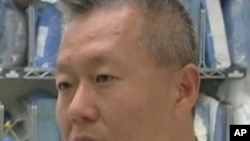Congresswoman Gabrielle Giffords is still reccovering from a gunshot wound to her head which she suffered January 8th while campainging in her home district in the western state of Arizona. At news conference on January 11th, Giffords' doctors said they are still "cautiously optimistic" about her survival. But that survival is still fraught with danger.
Most people who are shot in the head at close range do not survive. But for Congresswoman Gabrielle Giffords of Arizona, a lot of things went right. For one thing, she was in surgery less than 40 minutes afterward.
Dr. Peter Rhee, who heads the trauma center at the University of Arizona Hospital, said "Most of the people who come with a gunshot to the head don't come in here. They're already dead. Of the people who come with a gunshot to the head, most of them can't follow commands. When I hear someone's here, shot in the head [and] they can follow commands, I'm thinking, this is what we're here for."
Dr. Rhee said Giffords was not speaking, but he knew she was thinking. "When you tell her to squeeze your hand, she squeezes your hand. [When you tell her to] Let go, she lets go. She's thinking," he said.
Dr. Jonathan Slotkin is a neurosurgeon at Washington Hospital Center who has treated victims of gunshot wounds to the head. "From what I've been able to see, and analyze in this case, this was handled in a textbook A-plus way by the treatment team that's taking care of her," he said.
For example, Dr. Slotkin says it is important to act fast, and to remove part of the patient's skull. during surgery, "Almost every part of the body, if it gets swelling, has room to swell outward or downward or upward. The brain does not have that room because of the skull being a fixed compartment. So the goal of that surgery amongst others, is to create room for that brain to swell," he said.
At the news conference January 11, Giffords' doctors said they were able to cut back on the amount of sedatives she is receiving. .
"These are drugs whose action time is quite short. So when you shut them off, within minutes to a half an hour later, they can perform a neurologic examination on her and see how she's progressing," said Dr. Slotkin.
Dr. Slotkin says the challenge over the next few days centers on Giffords' ability to breathe without a breathing tube.
Back in Arizona, Dr. Michael Lemole, part of Giffords' medical team, says that's what he's waiting for. "What I want to see is her wake up to the point and interact with us to a point that Dr. Rhee and I look at each other and say, 'time to get that breathing tube out.'"
And that's because for every day the breathing tube is in place, Dr. Slotkin says the risk of pneumonia goes up. "The leading cause of death for her, coming on to the next several days is pneumonia," he said.
Which is one reason why Giffords' doctors stress that the congresswoman is not out of danger yet.










